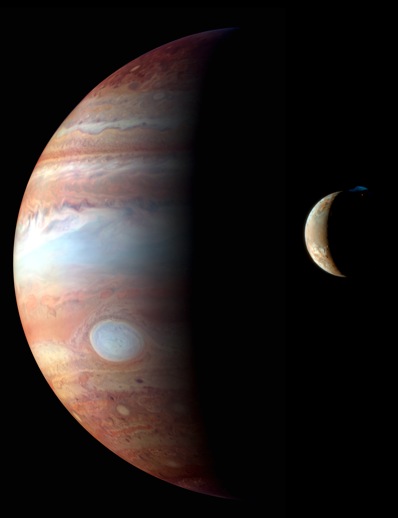|

New Horizons team celebrates 30th anniversary of Charon’s discovery
BY DR EMILY BALDWIN
ASTRONOMY NOW
Posted: July 3, 2008
On July 7 1978, Pluto was officially given its first moon, Charon, and just three years ago astronomers found two more. In seven years time it will receive its first artificial satellite – New Horizons – that will turn these distant bodies from points of light into well-mapped worlds.

The current location of the New Horizons spacecraft, which recently crossed Saturn's orbit. It is due for a rendezvous with Pluto and the Kuiper Belt objects in July 2015. Image: NASA/Johns Hopkins University Applied Physics Laboratory/Southwest Research Institute.
Charon was discovered by Naval Observatory astronomers James Christy and Robert Harrington, orbiting Pluto at a distance of about 18,220 kilometres from its surface. With a diameter half that of Pluto, Charon is the largest moon relative to its parent body in our Solar System.
“The historic discovery of Charon ushered in the modern understanding of Pluto as a double planet and the product of a giant collision that formed the system in much the same way as the Earth-Moon system was formed,” says Alan Stern, New Horizons Principal Investigator.
New Horizons will map the surface of Charon, which is thought to be covered in water ice, as well as thoroughly investigate the rest of Pluto’s family, Nix and Hydra, two much smaller moons, and the icy environs of the Kuiper Belt, to learn how these distant worlds were created and subsequently evolved.
Although there are still seven years before New Horizons reaches its destination, it recently passed the interplanetary milepost of Saturn after just two years and four months since launch, smashing Voyager 1’s record of three years and two months. As it crossed Saturn’s orbit just last month, it became the first spacecraft to venture this far into the Solar System since Voyager 2 sailed passed the ringed planet almost 27 years ago.

A montage of New Horizons images of Jupiter and its volcanic moon Io. A major volcanic eruption can be seen in the form of a great pume rising from Io's northern volcano Tvashtar, which appears blue as a result of scattering of light by small particles in the plume. Image: NASA/Johns Hopkins University Applied Physics Laboratory/Southwest Research Institute.
Although New Horizons was too far away to study Saturn, it was allowed a quick look at Jupiter and its moons as it picked up a vital gravity assist to sling it into the outer Solar System. New Horizons had also previously passed 102,000 kilometres from inner Solar System asteroid 2002 JF56, which allowed the spacecraft to test its optical navigation and tracking of moving targets capabilities.
New Horizons is now speeding through the outer Solar System at over 65,000 kilometres per hour and will be on the lookout for its next important landmark in the form of Uranus, which it is due to encounter in March 2011.
To read more about the New Horizons mission visit the mission homepage at: http://pluto.jhuapl.edu/index.php |



